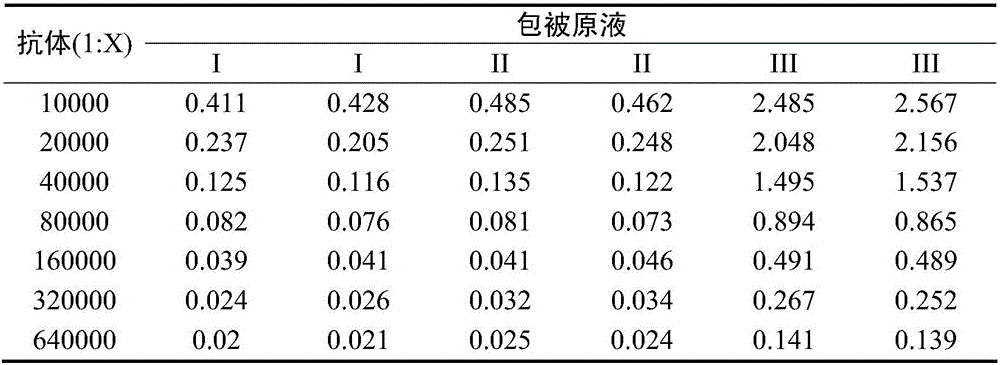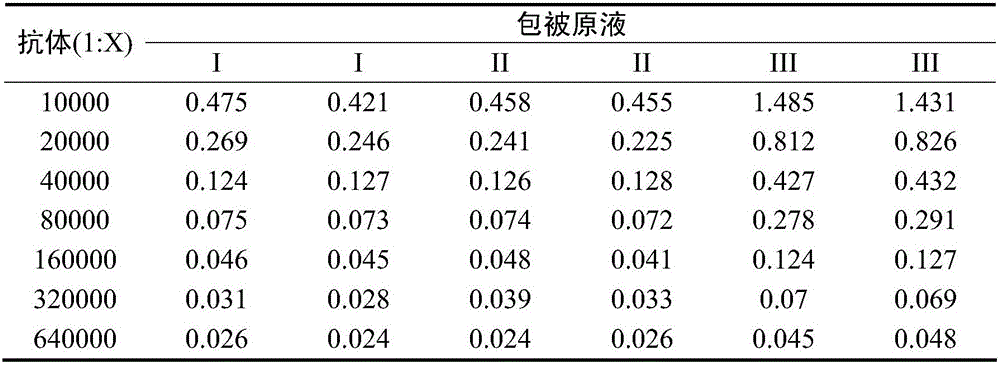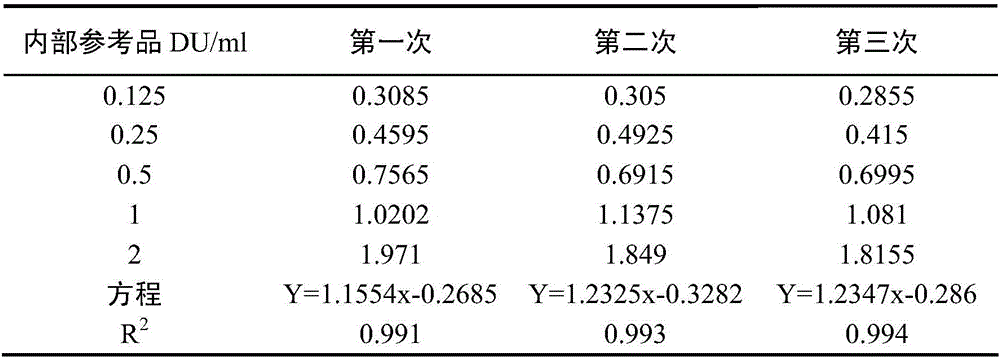Method for detecting content of D antigen in poliovirus type III
A poliovirus and poliovirus technology, applied in the field of antigen detection, can solve the problem that the poliovirus detection system cannot effectively distinguish
- Summary
- Abstract
- Description
- Claims
- Application Information
AI Technical Summary
Problems solved by technology
Method used
Image
Examples
Embodiment 1
[0022] Example 1 Preparation of Type III Poliovirus Polyclonal Antibody
[0023] The inactivated poliovirus type Ⅲ was emulsified with Freund's adjuvant, and immunized cattle and New Zealand white rabbits. Bovine immunization dose: 10ml of inactivated type III poliovirus mixed with 10ml of complete Freund's adjuvant for the first immunization by emulsification, followed by emulsification of 5ml with incomplete Freund's adjuvant of equal volume. Rabbit immunization dosage: 2ml of inactivated poliovirus type Ⅲ and 2ml of Freund's complete adjuvant mixed in equal volume for the first immunization, followed by emulsification immunization with 1ml and equal volume of Freund's incomplete adjuvant. Immune site: multiple points under the skin on the back of the neck. Immunization schedule: 0, 2, 4, 6 weeks. Blood was collected at 7 weeks, and serum was separated.
[0024] Indirect ELISA was used to detect the antibody titers of polyantiserum against polio Ⅰ, Ⅱ, Ⅲ, and to examine th...
Embodiment 2
[0030] Example 2 Establishment and linearity verification of a detection method for type III poliovirus D antigen
[0031] 1. Coating: Dilute the poliovirus type III bovine polyclonal antibody prepared in Example 1 at 1:4000 and mix evenly, add 100 μl / well to the microtiter plate, incubate overnight at 4°C; wash the plate 3 times, and pat dry .
[0032] 2. Blocking: prepare PBST-20 blocking solution containing 1% skimmed milk powder, 200 μl per well, and incubate at 37° C. for 120 minutes.
[0033] 3. D-antigen internal reference substance dilution: Use the national polio D-antigen standard substance to calibrate the D-antigen reference substance D-antigen content, and dilute the reference substance to make the concentrations 3, 1.5, 0.75, 0.375, and 0.1875 DU / ml.
[0034] 4. Adding samples: add the diluted standard substance to the microplate, 100 μl per well, add multiple wells for each dilution, and make the test sample dilution control well at the same time; incubate at...
Embodiment 3
[0043] Example 3 Precision verification of poliovirus type III D antigen detection system
[0044] In this example, the test sample type III poliovirus stock solution (Beijing Kexing Biological Products Co., Ltd.) was made in duplicate, one of which was not subjected to any treatment as a control (D antigen), named sample A; the other was prepared in a 56°C water bath 30min (H antigen), named sample B; mix sample A and sample B according to the volume ratio of 1:1, that is, the mixed sample of D antigen and H antigen in equal proportion, named sample C. This embodiment is operated by a single person, and for the test sample A, three independent operations are respectively carried out for detection. Operation steps are with embodiment 2. According to the OD value of statistical detection, the corresponding D antigen content is calculated according to the linear equation of the standard, and the average value, standard deviation and coefficient of variation are calculated.
[...
PUM
 Login to View More
Login to View More Abstract
Description
Claims
Application Information
 Login to View More
Login to View More - R&D
- Intellectual Property
- Life Sciences
- Materials
- Tech Scout
- Unparalleled Data Quality
- Higher Quality Content
- 60% Fewer Hallucinations
Browse by: Latest US Patents, China's latest patents, Technical Efficacy Thesaurus, Application Domain, Technology Topic, Popular Technical Reports.
© 2025 PatSnap. All rights reserved.Legal|Privacy policy|Modern Slavery Act Transparency Statement|Sitemap|About US| Contact US: help@patsnap.com



